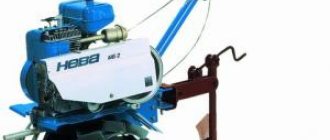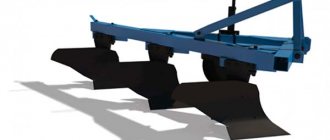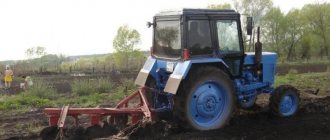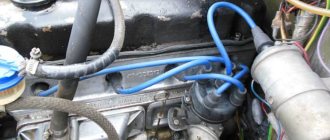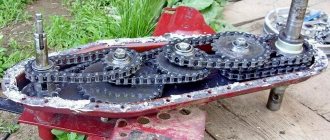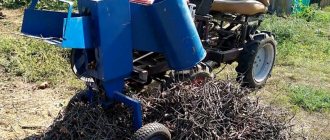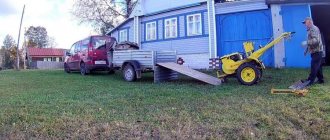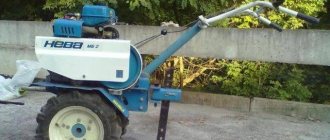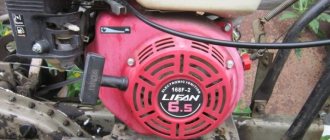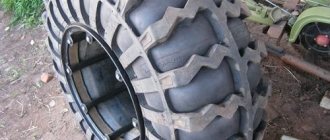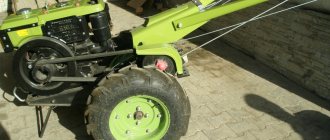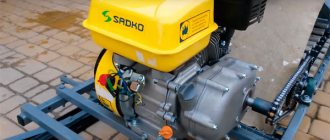Potatoes are a popular vegetable crop that is grown by many garden owners. It is worth noting that manually planting this vegetable is quite difficult. Owners of walk-behind tractors can simplify this procedure and purchase a special potato planter. However, before you do this, you need to understand the features of such accessories and how to use them correctly.
Potato planter - a device used for planting potatoes
Design and principle of operation
People who are seriously interested in a potato planter for a walk-behind tractor should figure out in advance what parts it consists of and how it works.
Main nodes
The motorized cultivator for planting potatoes was designed in such a way as to simplify the process of planting tubers as much as possible.
According to the general drawings, the device consists of the following parts:
- Potato bin. This is a special container through which tubers are fed during planting.
- Frame. Most often it is created from a metal pipe profile.
- Wheels. They are attached to a metal frame. They have a fairly large tread, thanks to which the potato planter for the walk-behind tractor moves better over the plowed ground.
- Chain elevator. This device is responsible for the flow of potatoes from the bunker into a special pipe, from which the tubers fall into the ground.
- Metal plow. Used to create furrows in the ground.
Many models of planters are equipped with a hiller. He sprinkles the planted potatoes with soil.
Equipment system
On what principle does such a device work? Its main components are a furrow-forming plow and a seeder for laying out potatoes. The task of the hiller is to cover the vegetables with soil. All this together makes up a sowing trailer attached to the walk-behind tractor. It is designed to create favorable conditions for further agronomic operations: weeding, loosening, hilling, digging.
The planting itself is carried out on pre-treated soil with high quality, quickly, with a selected depth and pitch. A quality tool should have good performance, durability, ease of assembly and ease of use. What matters is its size and weight, as well as its affordable price.
Main varieties
Before you buy a potato planter, you need to familiarize yourself with the main types of such devices.
Metal plow - used to create planting furrows
Negotiable
Many people prefer to use reversible designs. They plant potatoes in three stages:
- Creation of planting furrows.
- Planting tubers.
- Sprinkling the planted potatoes with soil.
The main advantage of such models can be considered their low cost. The fact is that reversible planters are an order of magnitude cheaper than bunker planters.
Bunker
Recently, people increasingly prefer bunker models.
Their main distinguishing feature from revolving structures is that they can be used to plant potatoes in one pass. Thanks to this, it is possible to plant a large number of tubers in just a few hours.
Despite all the advantages of bunker planters, they also have disadvantages. The disadvantages include the fact that they cannot be used to plant sprouted tubers.
Centaur
Centaur walk-behind tractors run on diesel and are made in China. Fuel economy and high efficiency are features of such machines. Planting potatoes with a Centaur walk-behind tractor does not require brute force, and large wheels allow the walk-behind tractor to easily overcome small obstacles.
For more information about the Centaur walk-behind tractor, watch the video:
Mole MK-4
The Mole MK-4 motor cultivator is suitable for small vegetable gardens. Its weight is 70 kilograms. The mole is equipped with a Honda gasoline engine with a power of 4 liters. With. Planting potatoes with a Mole MK-4 walk-behind tractor is unlikely to be convenient if you need to sow a large plot of land.
MTZ 05 MTZ 09
The Minsk Tractor Plant produces models of the “Belarus” family. MTZ-05 is a frameless single-axle walk-behind tractor with variable track. This model gained popularity in the domestic market, but was later supplanted by the new 09H.
The latest 9-horsepower model is more versatile and has six speeds; planting potatoes with the MTZ-05 09 walk-behind tractor should not cause any difficulties.
https://youtube.com/watch?v=yeVRpJ-RT74
With double hiller
Planting potatoes with a double hiller or double-row hiller on a Neva-MB2 walk-behind tractor is carried out as follows:
- The wings on the Neva are removed and lugs with iron extensions are installed.
- The distance from one hiller to another should be 65cm.
- The hitch is hung on metal pins.
- The beds are marked with a special device resembling a rake.
- The cultivator plows the marked ground at first speed.
- The tubers are placed in the bed at intervals of 35 centimeters.
- The grip of the hiller's wings expands.
- The potatoes are covered with earth.
- Rubber wheels are installed and the potatoes fall over again.
This method is suitable for a large volume of work.
OKA
OKA walk-behind tractors are also suitable for planting potatoes. They are equipped with a power take-off shaft, which makes them multitasking. The advantages of these domestic units are low cost, reliable operation on poor fuel, and an electronic ignition system.
Rotary plow
Planting potatoes with a walk-behind tractor using a rotary plow with backfill differs from usual in that the tractor plows in any direction. This saves a lot of fuel because you don't have to backtrack and re-do the furrow. Also, thanks to this, all work is carried out faster.
Under the plow
Potatoes can be planted with a motorized cultivator under the plow, and the garden does not require marking. This method is distinguished by the fact that the tubers are scattered immediately.
The Cayman, Patriot, Texas, Foreman, Viking, Forza walk-behind tractor is then installed in such a way that the bed is filled with soil from the next furrow. Due to this, landing is faster and smoother.
Salute 100
The Salute 100 walk-behind tractor is suitable for small jobs due to its lightness; for our procedure we will need a hitch and axle extensions. Before work, you need to remove the cutters from the axes and install extensions, and then lugs.
It is necessary to fix the hooks in the outer holes of the extensions to ensure the optimal width between the rows. The salute is equipped with a plowing depth limiter that needs to be removed, but otherwise the process is no different from the above.
FERMER
Planting potatoes with FERMER walk-behind tractors in small beds will be comfortable; it can be easily deployed and controlled, lifts the soil without problems and is suitable for both plow and hiller use. Saves fuel and is sold at an affordable price.
FORTE
Forte products are divided into two classes:
Lightweight, with a 4-stroke engine and a four-speed gearbox. These walk-behind tractors are easier to control and have off-road capability.
The heavy series has more powerful diesel engines and six speeds, which is suitable for working over large areas.
Distinctive features
Potato planters have several distinctive features that you need to familiarize yourself with in advance.
Bunker - container for potato tubers
Hopper size
Each planter for a walk-behind tractor has a special hopper for potato tubers. Its dimensions vary widely. When choosing, be sure to pay attention to the dimensions of the attachment.
It is recommended to use potato planters with large containers so that you do not have to add planting material too often.
Dimensions
Another distinctive feature of all potato planters is their dimensions. Different models differ from each other in their size.
When choosing this device, you need to take into account that oversized units weigh quite a lot and are difficult to control.
Quite often this causes a lot of problems when transporting and using planters. Therefore, it is recommended to buy medium-sized models.
There are also small-sized models. They are suitable for people who do not intend to plant too many potatoes at one time.
Adaptability
Previously, potato planters were created only for certain models of cultivators. Nowadays many universal units are produced that are compatible with most modern walk-behind tractors.
There are also special adapters. They allow you to combine the planters with almost any cultivator.
Hilling potatoes with a walk-behind tractor
Hilling is a soil cultivation process that is necessary not only during planting and growing vegetables. Attachments of this type are also useful for harvesting potatoes. With the help of a hiller, the soil is loosened, which facilitates the harvesting process.
The first hilling after planting is recommended to be done in moist soil. If it is dry, large lumps of earth will appear when loosening, which can damage still weak sprouts. The second hilling is performed after the stems reach 30 cm in height. If the soil is “breathable”, two treatments are sufficient. For dense soils, a third will be required. The rules for working with a walk-behind tractor when hilling are the same as when planting potatoes. It is important to set the ripper to the desired depth and try to maintain the evenness of the rows.
Setting up a hiller for planting potatoes
The features of the device and adjustment of the hiller can be studied in detail in the equipment operating instructions by viewing the detailed pictures and drawing presented there.
Before you start loosening the soil between the rows of potatoes, it is necessary to make individual adjustments to the hiller, taking into account the power of the walk-behind tractor, the type of soil, weather conditions, the characteristics of the working attachment mechanism and the quality of its sharpening.
Setting up the hiller is carried out after a test run of the motor-cultivator on virgin soil with the same type of soil, which allows you to set the optimal angle of attack, operating speed and other features of the unit.
- A properly adjusted disc hiller should be precisely aimed relative to the strip. To adjust, you need to place the equipment parallel to the furrows with the desired angle of inclination and width of the bed.
- To set the required angle of inclination, turn the screw adjustment device. The angle of inclination of the disc blades also determines the plowing depth.
- The disc hiller is adjustable in width. Depending on the distance between the rows of potatoes, the knives can be set to a width of 40 to 70 centimeters.
- The hiller is installed on the plot so that the discs do not touch the row with potatoes, but go exactly in the middle of the row spacing.
Dear farmers specializing in growing potatoes, do you use mounted potato planters? How often do you hill up the plant?
Criterias of choice
A potato planter on a walk-behind tractor is a device that many summer residents dream of. People who want to purchase such a unit must figure out how to choose it. There are several criteria that must be taken into account when choosing.
Compact planters are ideal for not very powerful walk-behind tractors
Size
The main criterion that must be taken into account when purchasing a potato planter is its size.
Many summer residents prefer to use large-sized models, as they are equipped with a large hopper that holds a lot of seed.
Such large devices are suitable for people who have to plant significant volumes of potatoes every year. For owners of small gardens, this is not the best choice; it is better for them to purchase small-sized planters with a small hopper.
Weight
When familiarizing yourself with the technical characteristics of the potato planter you are purchasing, you need to pay attention to its weight.
In many ways, it depends on it how convenient it will be to use the unit.
When choosing the appropriate weight of the planter, it is necessary to take into account the power of the walk-behind tractor.
For example, if it is not very powerful, you should not buy a large and heavy unit. In this case, it is better to look for a model that weighs no more than 50 kg.
Compatibility with walk-behind tractors
A huge number of different potato planters and potato diggers for walk-behind tractors are produced. It is worth noting that some of them may not be compatible with the cultivator you are using.
Therefore, before you buy a unit, you need to make sure that it is exactly suitable for the walk-behind tractor. To do this, you need to familiarize yourself with the description and technical characteristics of the device.
If you purchased a planter that is not suitable for a walk-behind tractor, you will have to look for a special adapter.
Additional functions
Some people believe that such devices can only be used for planting potatoes. In fact, this is far from the case.
Some potato planters plow the soil before planting the tubers
The fact is that some types of potato planters can perform various functions, among which the following can be distinguished:
- plowing the soil before planting;
- loosening the soil;
- spreading fertilizer after planting.
Models with the above additional features are ideal for people who grow a lot of potatoes to sell.
Adjustment options
Some planter models have the ability to manually adjust some parameters.
For example, in more expensive devices, anyone can independently set the distance between planted tubers, the row spacing, and the depth of the potatoes.
In newer units, you can manually adjust the height of the soil ridge formation.
DIY making
For a person who has the skills to assemble devices and tools, it will not be difficult to make auxiliary equipment on their own at home. This will not only save money, but also show your imagination and make the device for yourself.
First of all, you will need a steel frame that is 8mm in size and 2cm in height. The bunker is made small (since the equipment is designed for compact areas). Its weight will be 15-20 kg.
The elevator is installed inside the bunker; bowls with a diameter of 5-10 mm are placed inside. The entire mechanism is attached to the main wheel using a chain rope. It allows you to automate the process of planting potatoes.
Plate supports are mounted on both sides of the frame. Their task is to hold 2 seed tubes and discs for sealing furrows. Using steel strips, the frame is given a stable position. The plywood bin is attached to the bracket. It is usually covered with drying oil on top, then with varnish. Rubber is placed inside the bin to protect the fruit from damage. Next, wheels are attached to the device.
How to set up a planter
Before you start using the potato planter, you need to understand the features of its settings. First, you need to manually adjust the planting depth. It should be 10-15 centimeters. To manually adjust the depth, you will have to adjust the position of the support wheels.
You also need to choose the distance between planted potatoes. It should not be more than 25 centimeters. To adjust the planting density, you will need to adjust the position of the replacement sprocket.
If necessary, you can manually set the distance between rows. It is desirable that it be about 60-65 centimeters.
Harvesting
A walk-behind tractor is convenient not only for planting potatoes, but also for harvesting them. This is done in early autumn (September-October) in dry weather. To do this, an additional device is installed on the unit - a plower. Sometimes it is called a “potato digger” or digger. He digs the ground and takes out the tubers.
You can see how the harvest is dug up in this video
But you don't have to use it. It is enough to use a single-row hiller. He will lift the ground, and the potatoes will lie on the edge of the bed. All that remains is to go around the area and collect the ripe crop.
To avoid potato germination, after harvesting it should be placed in a dark, cool place. There it should lie for 2-3 weeks. Afterwards, the potatoes need to be sorted by size. And only after that send it to the cellar.
Models of potato planters
There are several planters that were created specifically for certain models of walk-behind tractors.
Neva
The potato planter for the Neva walk-behind tractor is a compact and small-sized device. This model boasts additional functions. For example, it can be used to apply fertilizers during planting.
For Neva walk-behind tractors it is better to buy small planters
ATZ
A potato planter with a chain for ATZ and MTZ walk-behind tractors is an excellent device for quickly planting potatoes.
Among the features of this model, one should highlight its light weight - only 25 kg.
Agate
This is a fairly large unit with a large bunker. It holds about two buckets of potatoes. Other features of this model include the fact that it can be used for plowing or loosening the soil.
A potato planter is a fairly useful device that makes planting potatoes much easier. People who are planning to purchase such a device must understand its features and how to choose it correctly.
Owner reviews
The use of this unit when planting potatoes leaves only positive feedback:
- Yuri’s statement: “Due to health reasons, I was unable to begin planting work manually. But it needs to be done. Having purchased the device, I immediately understood how to plant potatoes with a walk-behind tractor, and felt the advantages in ease of use and speed of execution.”
- Review from Vitaly: “I had a walk-behind tractor, which I used only for cultivating the land. Having seen on the Internet that you can make a potato planter with your own hands, I immediately got excited about this idea. When the work was completed, I couldn’t be happier with my own product. Excellent cost savings and an assistant in the difficult work of the farmer.”
Tags : plot, hectares, distance, should, dimensions, carried out, type, planters, tractor, others, store, region, buy, potato digger, however, use, small-sized, intended, hour, many, double-row, plantings, question, any, case, work, single-row, depends, directly, MTZ, speed, potatoes, will help, mini tractors, availability, assemble, couplings, plant, it, sprockets, order, depth, movement, has, assembly, track, agricultural, tank, selected, any
